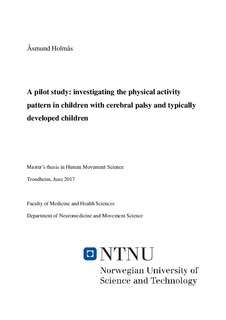| dc.description.abstract | Background: There’s a concern that children today are too inactive, and technology makes it possible for children to reach out to their friends from the sofa, instead of standing up and walking out to meet them. Children with cerebral palsy (CP) experience motor disabilities and this may also impact their participation in daily activities. Since children change environment throughout their week, the activity patterns could possibly depend on whether it’s during school time, leisure time during weekdays or weekends. Aim: To apply the NTNU IDI software on one week Axivity sensor recordings from children with and without CP, to detect various activities, and provide feedback for further development of the study. Also, to investigate any differences in TD children between gender and age groups for time spent in sedentary, standing position and activity during school time, and leisure time during weekdays and weekend, as well as if the activity distribution is similar between CP and TD children, or as similarly depending on the time of the week. Methods: 75 typically developed (TD) children between 7-15 years old, and 11 CP children (GMFCS level I-II) between 4-16 years old used an activity diary and wore two accelerometers (Axivity AX3) for 1 week, with the use of the NTNU IDI software algorithm, to measure activity patterns during school time, and leisure time in weekdays and weekends. Results: During school time, secondary school TD children were significantly less active compared to primary school TD children, but during leisure time in weekdays and weekends, secondary school TD children were overall either similar or less in sedentary position compared to the primary school TD children. 7-9 years old TD boys show trends of higher overall activity compared to girls during school time and leisure time during weekdays, but not during the weekend, and there were no overall gender differences among 10-15 years old TD children. There were not found any significant differences in activity patterns between TD and CP children in neither school time, leisure time during weekdays or weekend. Conclusion: For further development of the study, it was found that the activity diary entries from the participants of when they slept and woke up, were imprecise compared to the accelerometer data timeline, and not useful in the data analysis. Older TD children were overall less active during school time than younger TD children, while during weekends, the youngest TD children spent more time in sedentary position than the oldest TD children. The youngest boys showed certain trends of overall higher activity than the youngest girls, but among older TD children there were found no gender differences. There were not found any differences between CP and TD children’s activity pattern. | nb_NO |
